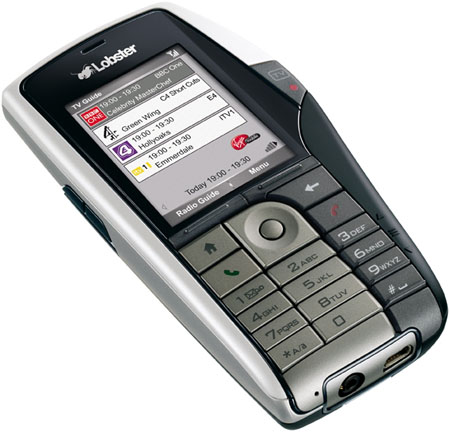This article is more than 1 year old
TV body seeks attractive mobile operators for mutual action replays
Mobile TV? Don't laugh - it might actually work
If mobile TV flopped then, why would it work now?

Ugly - who you calling ugly? Virgin's Lobster TV mobile.
A quick recap of the history of mobile TV shows why a low-key launch was wise. Lots of services were launched, but whether the video was delivered using cellular, operator-managed spectrum, or over terrestrial broadcasting spectrum, the outcome was the same – punters stayed away.
The US was first out of the block back in 2004, with Verizon pushing Qualcomm’s MediaFlo multicast technology, which ran over CDMA. AT&T signed up to this, apparently because it had won some spectrum, but never actually launched. MediaFlo was turned off in 2011 and the 700Mhz spectrum was resold.
European operators dabbled with their own answer to MediaFlo, using MBMS standards, but decided not to proceed.
Meanwhile, European bureaucrats got very excited about DVB-H, which used a variation of the DVB-T digital TV standard. Nokia spent a small fortune promoting it, and a huge fortune would have been needed to create a parallel mobile digital TV transmission infrastructure.
But this was a technology where the egg couldn’t roll away from the chicken fast enough, which was legging it in the opposite direction. It never got much support from either handset manufacturers or operators on one side, or punters on the other.
The same could be said of mutant oddities like Virgin’s Lobster, which used DAB radio’s data capacity to stream TV. It was pulled after less than a year, gathering "considerably fewer than 10,000" paying subscriptions.
So why would it be any different this time? Well, technology has improved. But broadcasters and operators now have a different set of incentives. They now have a common enemy: OTT.
OTT (Over the Top) video is the Pacman that destroys the business, giving operators no revenue or customer retention upside, robs them of interesting partnerships, while leaving them with an inefficient, barely manageable mess. They’d much rather manage what flows over their networks.
And lastly, they’re just a bit more sensible these days. For much of the past 15 years, mobile strategists got stoned on visions of replacing TV. For a while, the annual global mobile show, Mobile World Congress, was overrun with greedy and speculative TV and movie reps, believing what the mobile hypesters had sold them. Today, nobody in either industry believes the public wants to watch linear digital TV on a phone.
Yet more modest video services are clearly within reach. I know one Arsenal season ticket holder – who can see both giant screens from his seat – who’d consider switching operators to watch replays.
And while the public clearly doesn't want to watch linear TV on phones most of the time - they do find time-shifting and place-shifting, and "watch it later" to be quite useful.
It’s harder to imagine all this not becoming commonplace in the next decade, really. The hard work is getting everyone else – particularly Apple – to agree. ®
